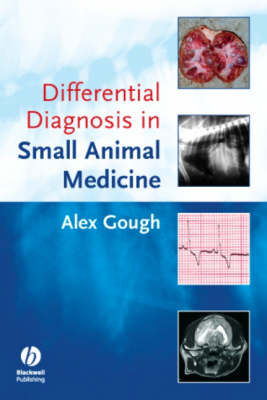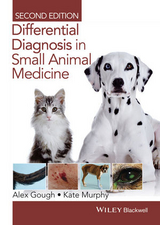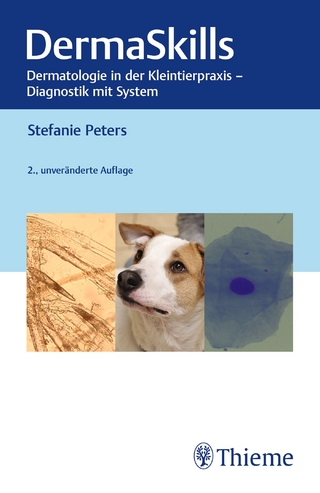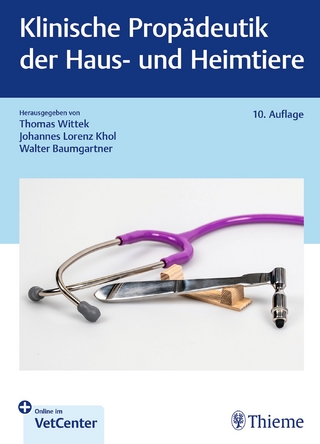
Differential Diagnosis in Small Animal Medicine
Wiley-Blackwell (an imprint of John Wiley & Sons Ltd) (Verlag)
978-1-4051-3252-7 (ISBN)
- Titel erscheint in neuer Auflage
- Artikel merken
Alex Gough is a partner in a referral and first opinion practice in Bath, UK, where he sees referrals in small animal medicine and cardiology. He is the author of Differential Diagnosis in Small Animal Medicine, also published by Wiley-Blackwell, and is a frequent contributor to UK Vet and the Veterinary Times.
Introduction. Part I: Historical signs:. Chapter 1.1. General, systemic and metabolic historical signs. 1.1 (i) Polyuria/polydipsia. 1.1 (ii) Weight loss. 1.1 (iii) Weight gain. 1.1 (iv) Polyphagia. 1.1 (v) Anorexia/inappetence. 1.1 (vi) Failure to grow. 1.1 (vii) Syncope/collapse. 1.1 (viii) Weakness. Chapter 1.2. Gastro-intestinal/abdominal historical signs. 1.2 (i) Ptyalism/salivation/hypersalivation. 1.2 (ii) Gagging/retching. 1.2 (iii) Dysphagia. 1.2 (iv) Regurgitation. 1.2 (v) Vomiting. 1.2 (vi) Diarrhoea. 1.2 (vii) Melaena. 1.2 (viii) Haematemesis. 1.2 (ix) Haematochezia. 1.2 (x) Constipation/obstipation. 1.2 (xi) Faecal tenesmus/dyschezia. 1.2 (xii) Faecal incontinence. 1.2 (xiii) Flatulence/borborygmus. Chapter 1.3. Cardio-respiratory historical signs. 1.3 (i) Coughing. 1.3 (ii) Dyspnoea/tachypnoea. 1.3 (iii) Sneezing and nasal discharge. 1.3 (iv) Epistaxis. 1.3 (v) Haemoptysis. 1.3 (vi) Exercise intolerance. Chapter 1.4. Dermatological historical signs. 1.4 (i)Pruritus. Chapter 1.5. Neurological historical signs. 1.5 (i) Seizures. 1.5 (ii) Trembling/shivering. 1.5 (iii) Ataxia/ conscious proprioceptive deficits. 1.5 (iv) Paresis/paralysis. 1.5 (v) Coma/stupor. 1.5 (vi) Altered behaviour. 1.5 (vii) Deafness. 1.5 (viii) Multifocal neurological disease. Chapter 1.6. Ocular historical signs. 1.6 (i) Blindness/visual impairment. 1.6 (ii) Epiphora/tear overflow. Chapter 1.7. Musculoskeletal historical signs. 1.7 (i) Forelimb Lameness. 1.7 (ii) Hindlimb lameness. 1.7 (iii) Multiple joint/limb lameness. Chapter 1.8. Reproductive historical signs. 1.8 (i) Failure to observe oestrus. 1.8 (ii) Irregular seasons. 1.8 (iii) Infertility in the female with normal oestrus. 1.8 (iv) Male infertility. 1.8(v) Vaginal/Vulval discharge. 1.8 (vi) Abortion. 1.8 (vii) Dystocia. 1.8(viii) Neonatal mortality. Chapter 1.9. Urological historical signs. 1.9 (i) Pollakiuria/dysuria/stranguria. 1.9 (ii) Polyuria/polydipsia. 1.9 (iii) Anuria/oliguria. 1.9 (iv) Haematuria. 1.9 (v) Urinary incontinence. Part II: Physical signs:. Chapter 2.1. General/miscellaneous physical signs. 2.1 (i) Abnormalities of body temperature. 2.1 (ii) Enlarged lymph nodes. 2.1 (iii) Diffuse pain. 2.1 (iv) Peripheral oedema. 2.1 (v) Hypertension. 2.1 (vi) Hypotension. Chapter 2.2. Gastro-intestinal/abdominal physical signs. 2.2 (i) Oral lesions. 2.2 (ii) Abdominal distension. 2.2 (iii) Abdominal pain. 2.2 (iv) Perianal swelling. 2.2 (v) Jaundice. 2.2 (vi) Abnormal liver palpation. Chapter 2.3. Cardiorespiratory physical signs. 2.3 (i) Dyspnoea/tachypnoea. 2.3 (ii) Pallor. 2.3 (iii) Shock. 2.3 (iv) Cyanosis. 2.3 (v) Ascite. 2.3 (vi) Peripheral oedema. 2.3 (vii) Abnormal respiratory sounds. 2.3 (viii) Abnormal heart sounds. 2.3 (ix) Abnormalities in heart rate. 2.3 (x) Jugular distension/positive hepatojugular reflux. 2.3 (xi) Increased size of jugular pulse. 2.3 (xii) Alterations in arterial pulses. Chapter 2.4. Dermatological signs. 2.4 (i) Scaling. 2.4 (ii) Pustules and papules (including miliary dermatitis). 2.4 (iii) Nodules. 2.4 (iv) Pigmentation disorders (coat or skin). 2.4 (v) Alopecia. 2.4 (vi) Erosive/ulcerative skin disease. 2.4 (vii) Otitis externa. 2.4 (viii) Pododermatitis. 2.4 (ix) Disorders of the claws. 2.4 (x) Anal sac disease/perianal disease. Chapter 2.5. Neurological signs. 2.5 (i) Abnormal cranial nerve responses. 2.5 (ii) Vestibular disease (head tilt, nystagmus, circling, leaning, falling, rolling). 2.5 (iii) Horner's syndrome. 2.5 (iv) Hemineglect syndrome. 2.5 (v) Spinal disorders. Chapter 2.6. Ocular signs. 2.6 (i) Red eye. 2.6 (ii) Corneal opacification. 2.6 (iii) Corneal ulceration. 2.6 (iv) Lens lesions. 2.6 (v) Retinal lesions. 2.6 (vi) Intraocular haemorrhage/hyphaema. 2.6 (vii) Abnormal appearance of anterior chamber. Chapter 2.7. Musculo-skeletal signs. 2.7 (i) Muscular atrophy or hypertrophy. 2.7 (ii) Trismus. 2.7 (iii) Weakness. Chapter 2.8. Uro-genital physical signs. 2.8 (i) Abnormal kidney palpation. 2.8 (ii) Bladder abnormalities. 2.8 (iii) Abnormal palpation of prostate. 2.8 (iv) Abnormal palpation of uterus. 2.8 (v) Testicular abnormalities. 2.8 (vi) Penis abnormalities. Part III: Radiographic and ultrasonographic signs:. Chapter 3.1. Thoracic radiography. 3.1 (i) Artefactual causes of increased lung opacity. 3.1 (ii) Increased bronchial pattern. 3.1 (iii) Increased alveolar pattern. 3.1 (iv) Increased interstitial pattern. 3.1 (v) Increased vascular pattern. 3.1 (vi) Decreased vascular pattern. 3.1 (vii) Cardiac diseases which may be associated with a normal cardiac silhouette. 3.1 (viii)Increased size of cardiac silhouette. 3.1 (ix)Decreased size of cardiac silhouette. 3.1 (x) Abnormalities of ribs. 3.1 (xi) Abnormalities of oesophagus. 3.1 (xii) Abnormalities of trachea. 3.1 (xiii) Pleural effusion. 3.1 (xiv) Pneumothorax. 3.1 (xv) Abnormalities of diaphragm. 3.1 (xvi) Mediastinal abnormalities. Chapter 3.2. Abdominal radiography. 3.2 (i) Liver. 3.2(ii) Spleen. 3.2 (iii) Stomach. 3.2 (iv) Intestines. 3.2 (v) Ureters. 3.2 (vi) Bladder. 3.2 (vii) Urethra. 3.2 (viii) Kidneys. 3.2 (ix) Loss of intra-abdominal contrast. 3.2 (x) Prostate. 3.2 (xi) Uterus. 3.2 (xii) Abdominal masses. 3.2 (xiii) Abdominal calcification/mineral density. Chapter 3.3. Skeletal radiography. 3.3 (i) Fractures. 3.3 (ii) Altered shape of long bones. 3.3 (iii) Dwarfism. 3.3 (iv) Delayed ossification/growth plate closure. 3.3 (v) Increased radiopacity. 3.3 (vi) Periosteal reactions. 3.3 (vii) Bony masses. 3.3 (viii) Osteopenia. 3.3 (ix) Osteolysis. 3.3 (x) Mixed osteolytic/osteogenic lesions. 3.3 (xi) Joint changes. Chapter 3.4. Radiography of the head and neck. 3.4(i) Increased radiopacity/bony proliferation of the maxilla. 3.4(ii) Decreased radiopacity of the maxilla. 3.4(iii) Increased radiopacity/bony proliferation of mandible. 3.4 (iv) Decreased radiopacity of mandible. 3.4 (v) Increased radio-opacity of tympanic bulla. 3.4 (vi)Decreased radiopacity of the nasal cavity. 3.4 (vii) Increased radiopacity of the nasal cavity. 3.4(viii) Increased radiopacity of the frontal sinuses. 3.4 (ix) Increased radiopacity of pharynx. 3.4 (x) Thickening of soft tissues of head and neck. 3.4 (xi) Decreased radiopacity of soft tissues of head and neck. 3.4 (xii) Increased radiopacity of soft tissues of head and neck. Chapter 3.5. Radiography of the spine. 3.5 (i) Variation in vertebral shape and size. 3.5 (ii) Changes in vertebral radiopacity. 3.5 (iii) Abnormalities in the intervertebral space. 3.5 (iv) Contrast radiography of the spine (myelography). Chapter 3.6. Thoracic ultrasonography. 3.6 (i) Pleural effusion. 3.6 (ii) Mediastinal masses. 3.6 (iii)Pericardial effusion. 3.6 (iv) Enlarged chamber size. 3.6 (v) Changes in ejection phase indices of left ventricular performance. Chapter 3.7. Abdominal ultrasonography. 3.7 (i) Renal disease. 3.7 (ii) Hepato-biliary disease. 3.7 (iii) Splenic disease. 3.7 (iv) Pancreatic disease. 3.7 (v) Adrenal disease. 3.7 (vi) Urinary bladder disease. 3.7 (vii) Gastrointestinal disease. 3.7 (viii) Ovarian and uterine disease. 3.7 (ix) Prostatic disease. 3.7 (x)Ascites. Chapter 3.8 Ultrasonography of other regions. 3.8 (i) Testes. 3.8 (ii) Eyes. 3.8 (iii) Neck. Part IV: Laboratory findings:. Chapter 4.1. Biochemical findings. 4.1 (i) Albumin. 4.1 (ii) Alanine transferase. 4.1 (iii) Alkaline phosphatase. 4.1(iv) Ammonia. 4.1 (v) Amylase. 4.1 (vi) Aspartate aminotransferase. 4.1 (vii) Bilirubin. 4.1 (viii) Bile acids/dynamic bile acid test. 4.1 (ix) C-reactive protein. 4.1 (x) Cholesterol. 4.1 (xi) Creatinine. 4.1 (xii) Creatine kinase. 4.1 (xiii) Ferritin. 4.1 (xiv) Fibrinogen. 4.1 (xv) Folate. 4.1 (xvi) Fructosamine. 4.1 (xvii) Gamma-glutamyl transpeptidase. 4.1 (xviii) Gastrin. 4.1 (xix) Globulins. 4.1 (xx) Glucose. 4.1 (xxi) Iron. 4.1 (xxii) Lactate dehydrogenase. 4.1 (xxiii) Lipase. 4.1 (xxiv) Triglycerides. 4.1 (xxv) Trypsin-like immuno-reactivity. 4.1 (xxvi) Urea. 4.1 (xxvii)Vitamin B12(cobalamin). 4.1 (xxviii) Zinc. Chapter 4.2. Haematological findings. 4.2 (i) Regenerative anaemia. 4.2 (ii) Poorly/non-regenerative anaemia. 4.2 (iii) Polycythaemia. 4.2 (iv) Thrombocytopenia. 4.2 (v) Thrombocytosis. 4.2 (vi) Neutrophilia. 4.2 (vii) Neutropenia. 4.2 (viii) Lymphocytosis. 4.2 (ix) Lymphopenia. 4.2 (x) Monocytosis. 4.2 (xi) Eosinophilia. 4.2 (xii) Eosinopenia. 4.2 (xiii) Mastocythaemia. 4.2 (xiv) Basophilia. 4.2 (xv) Increased buccal mucosal bleeding time (disorders of primary haemostasis). 4.2 (xvi) Increased prothrombin time (disorders of extrinsic and common pathways). 4.2 (xvii) Increased partial thromboplastin time or activated clotting time (disorders of intrinsic and common pathways). 4.2 (xviii) Increased fibrin degradation products. 4.2 (xix) Decreased fibrinogen levels. 4.2 (xx) Decreased antithrombin III levels. Chapter 4.3. Electrolyte and blood gas findings. 4.3 (i) Total Calcium. 4.3 (ii) Chloride. 4.3 (iii) Magnesium. 4.3 (iv) Potassium. 4.3 (v) Phosphate. 4.3 (vi) Sodium. 4.3 (vii) pH. 4.3 (viii) pa02. 4.3 (ix) total C02. 4.3 (x) Bicarbonate. 4.3 (xi) Base excess. Chapter 4.4. Urinalysis findings. 4.4 (i) Alterations in specific gravity. 4.4 (ii) Abnormalities in urine chemistry. 4.4 (ii) a. Glucose. 4.4 (ii) b. Blood. 4.4 (ii) c. Haemoglobin. 4.4 (ii) d. Bilirubin. 4.4 (ii) e. Myoglobin. 4.4 (ii) f. Urobilinogen. 4.4 (ii) g. Nitrite. 4.4 (ii) h. Protein. 4.4 (ii) i. pH. 4.4 (ii) j. ketones. 4.4 (iii) Abnormalities in urine sediment. 4.4 (iii) a. Increased white blood cells. 4.4 (iii) b. Increased red blood cells. 4.4 (iii) c. Casts. 4.4 (iii) d. Crystals (predisposing factors). 4.4 (iv) Infectious agents. Chapter 4.5 Cytological findings. 4.5 (i) Tracheal/Bronchoalveolar lavage. 4.5 (ii) Nasal flush cytology. 4.5 (iii) Liver cytology. 4.5 (iv) Kidney cytology. 4.5 (v) Skin scrapes/hair plucks/tape impression. 4.5 (vi) Cerebrospinal fluid analysis. 4.5 (vii) Fine needle aspiration of cutaneous/subcutaneous masses. Chapter 4.6. Hormones/endocrine testing. 4.6 (i) Thyroxine. 4.6 (ii) Parathyroid hormone. 4.6 (iii) Cortisol (Baseline or post-ACTH stimulation test). 4.6 (iv) Insulin. 4.6 (v) ACTH. 4.6 (vi) Vitamin D (1,25 dihydroxycholecalciferol). 4.6 (vii) Testosterone. 4.6 (viii) Progesterone. 4.6 (ix) Oestradiol. 4.6 (x) Atrial natriuretic peptide. 4.6 (xi) Modified water deprivation test (in investigation of polyuria/polydipsia). Chapter 4.7 Faecal analysis findings. 4.7 (i) Faecal blood. 4.7 (ii) Faecal parasites. 4.7 (iii) Faecal culture. 4.7 (iv) Faecal fungal infections. 4.7 (v) Undigested food residues. PART V: Electrodiagnostic testing:. Chapter 5.1. ECG findings. 5.1 (i) Alterations in P wave. 5.1 (ii) Alterations in QRS complex. 5.1 (iii) Alterations in P-R relationship. 5.1 (iv) Alterations in S-T segment. 5.1 (v) Alterations in Q-T interval. 5.1 (vi) Alterations in T wave. 5.1 (vii) Alterations in baseline. 5.1 (viii) Rhythm alterations. 5.1 (xi) Alterations in rate. Chapter 5.2. Electromyographic findings. Chapter 5.3 Nerve conduction velocity findings. Chapter 5.4 Electroencephalography findings. PART VI: Diagnostic procedures:. 6.1 FNA. 6.2 Broncho-alveolar lavage. 6.3 Gastro-intestinal endoscopic biopsy. 6.4 ECG procedure. 6.5 MRI brain, spine, nose. 6.5 (i) Brain. 6.5 (ii) Spine. 6.5 (iii) Nasal passages. 6.6 Ultrasound guided biopsy. 6.7 CSF collection. 6.8 Bone marrow aspiration/biopsy. 6.9 Thoracocentesis. 6.10 Pericardiocentesis. 6.11 Cystocentesis. 6.12 Abdominocentesis/ Diagnostic peritoneal lavage. 6.13 Central venous measurement. 6.14 ACTH stimulation test. 6.15 Low dose dexamethasone supression test/high dose dexamethasone suppression test. 6.16 Bile acid stimulation test. 6.17 In saline autoagglutination test. 6.18 Preparation of a blood smear. 6.19 Water deprivation test. 6.20 Serial blood glucose curve. 6.21 Indirect blood pressure measurement by Doppler technique. 6.22 Skin scraping. 6.23 Schirmer tear test. 6.24 Nasal flush cytology/nasal biopsy. 6.25 Barium meal/swallow. 6.26 Intravenous urography. 6.27 Contrast cystography pneumo, double, vagino-urethro. 6.28 Myelography. 6.29 Contrast echocardiography. 6.30 Cranial nerve examination. 6.31 Buccal mucosal bleeding time. 6.32 Arterial blood sampling. PART VII: Diagnostic Algorithms. 7.1 Bradycardia. 7.2 Tachycardia. 7.3 Hypoalbuminaemia. 7.4 Non-regenerative anaemia. 7.5 Regenerative anaemia. 7.6 Jaundice. 7.7 Hypokalaemia. 7.8 Hyperkalaemia. 7.9 Hypocalcaemia. 7.10Hypercalcaemia. 7.11 Systemic hypertension. Appendix A: History Record. Appendix B Physical Examination Record. Appendix C Neurological Examination Chart. Appendix D Cardiology Consultation Form. Bibliography and further reading
| Erscheint lt. Verlag | 5.10.2007 |
|---|---|
| Zusatzinfo | 66 illustrations |
| Verlagsort | Chicester |
| Sprache | englisch |
| Maße | 173 x 243 mm |
| Gewicht | 1040 g |
| Themenwelt | Veterinärmedizin ► Kleintier |
| ISBN-10 | 1-4051-3252-3 / 1405132523 |
| ISBN-13 | 978-1-4051-3252-7 / 9781405132527 |
| Zustand | Neuware |
| Informationen gemäß Produktsicherheitsverordnung (GPSR) | |
| Haben Sie eine Frage zum Produkt? |
aus dem Bereich



